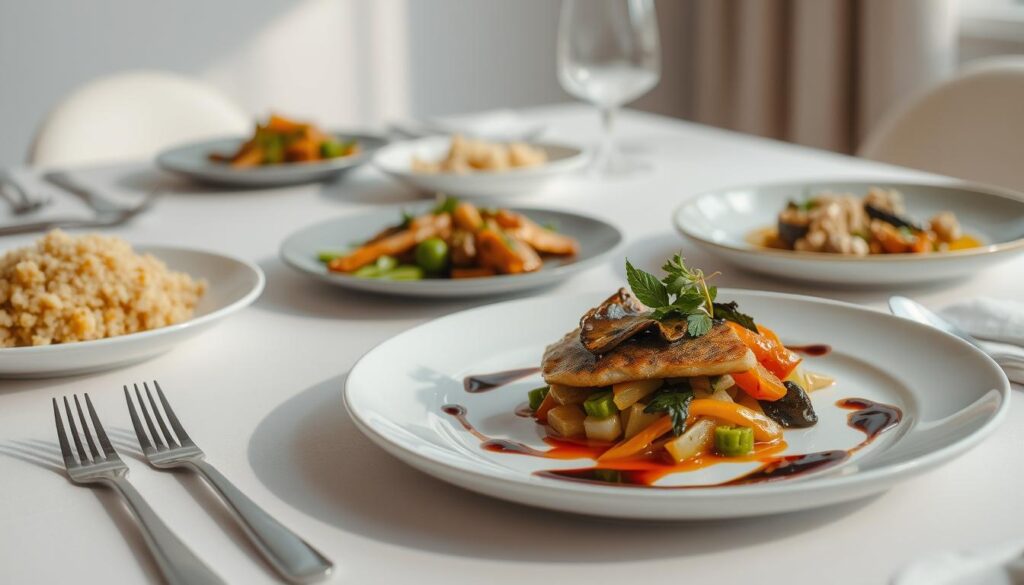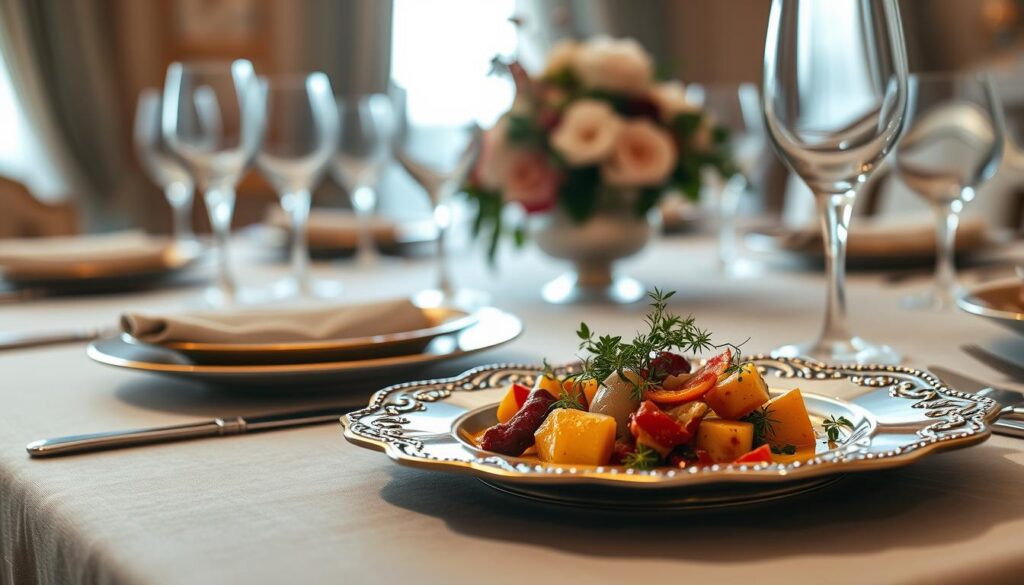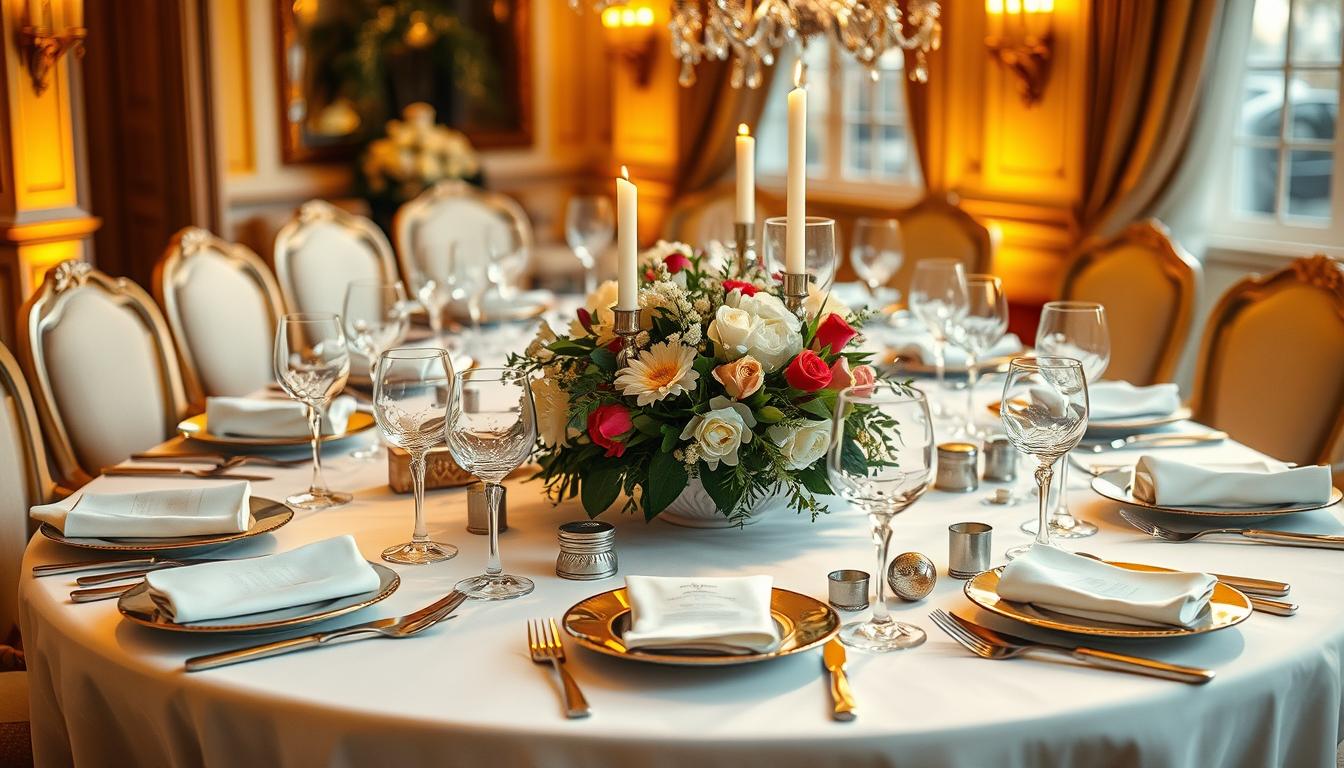We know how important food presentation is. A beautifully presented dish can really enhance your meal. We’ll share expert tips on how to make your dinner presentations stunning. You’ll learn about plating, delicious recipes, and how to make your dinner parties Instagram-worthy.
Imagine a dinner party where the food is so eye-catching it starts conversations. With the right tips and recipes, you can make it happen. We’ll explore the best ways to make your dishes look amazing. Whether you’re a pro or just starting, our guides will help you improve your food presentation skills.
We want to give you the skills to create unforgettable dining experiences. By following our guides, you’ll impress your guests with beautiful dinner presentations. We’ll cover everything from lighting to color theory, so you can take your hosting to the next level.
Key Takeaways
- Food presentation is key to a great dining experience, with 70% of diners saying it affects their satisfaction.
- White plates can make food seem more valuable by up to 25%. Colorful meals can boost appetite and satisfaction by 15%.
- Adding texture variety in plating can improve the meal by about 35%. The rule of thirds can make dishes look 40% better.
- Lighting is vital in food presentation, with nearly 80% of food bloggers saying it’s important for social media photos.
- Mastering food presentation can make your dining experiences unforgettable for your guests.
- Our guides will give you the knowledge and inspiration to improve your hosting and create stunning dinner presentations.
- With the right plating tips, recipes, and ideas, you can impress your guests and make your dinner parties unforgettable.
The Importance of Meal Presentation
Dinner presentation ideas are key to a memorable meal. A beautifully presented dish can excite the senses and leave a lasting impression. Studies reveal that about 90% of a dish’s first impression comes from how it looks.
Creating dishes that look great and taste amazing is important. You can use colors, textures, and garnishes to make a dish stand out. For instance, adding edible flowers or microgreens can bring freshness and color to the plate. This way, you make a dish that’s not just delicious but also beautiful to look at.
To impress your guests, try using different textures and garnishes. Fresh herbs or citrus wheels can add a nice touch. Experimenting with colors and patterns can also make your dish unique and eye-catching. By following these tips, you’ll create memorable dinner presentations that will wow your guests.
Essential Tools for Meal Presentation
The right tools can make a big difference in a memorable dining experience. We’ll look at the key tools for meal presentation, like plating tips, dishware, and garnishes. These elements can take your dinner recipes to the next level and impress your guests.
A well-presented meal can make the dish seem more valuable. Studies show that using plates with contrasting colors can improve food presentation. Also, odd numbers of food items can add visual appeal and interest.
Plating Tools We Recommend
Effective food plating often uses the “Rule of Thirds.” This means placing the dish’s focal point off-center for more visual interest. High-end culinary presentations mix textures, like smooth sauces with crunchy garnishes, to enhance the dining experience.
Choosing the Right Dishware
The ratio of food to plate can make a dish look artistic. Smaller portions on larger plates ensure more white space, making the dish appealing. Bright colors look good against dark backgrounds, while neutral colors work well with white.
Using Garnishes Effectively
Research shows garnishes should be edible and placed thoughtfully to improve the meal. Modern trends lean towards minimalistic and intentional garnishing. By using these essential tools and plating tips, you can create stunning dinner recipes that impress your guests.
| Tool | Description |
|---|---|
| Plating Tools | Used to create visually appealing dishes |
| Dishware | Selected to complement the colors and textures of the meal |
| Garnishes | Added to enhance the flavor and presentation of the dish |
Understanding Color Theory in Food
Creating Instagram-worthy dinner presentations starts with color theory. The right colors can make your dish look appealing. The wrong ones can make it look off-putting. Think about the food, plate, and background colors.
Contrasting colors are key in color theory. They make your dish stand out. For example, a dark dish looks better on a light plate. Adding garnishes with contrasting colors adds a pop.
- Warm colors like red, orange, and yellow boost appetite and welcome guests.
- Cool colors like blue and green calm and freshen your dish.
- Contrasting colors make your presentation pop.
- Think about the food, plate, and background colors.
Follow these tips to make your dinner presentations impressive. Remember to consider the colors of the food, plate, and background. Use contrasting colors for a stunning presentation.
| Color | Effect on Appetite | Common Use |
|---|---|---|
| Red | Stimulates appetite | Fast food industry |
| Orange | Stimulates appetite and sales | Casual dining settings |
| Yellow | Causes uneasiness, benefits fast food restaurants | Fast food industry |
Textures and Layers in Presentation
Textures and layers are key in making food look good. Mixing different textures like crunchy, smooth, and soft adds depth to our dishes. It’s important to balance soft and crisp elements for a beautiful presentation.
Here are some tips for textures and layers in food presentation:
- Play with textures like crunchy veggies and smooth sauces.
- Build layers for visual interest with meats, veggies, and grains.
- Balance soft and crisp elements for a harmonious look.

Mastering textures and layers can make our dinner recipes stand out. With practice, anyone can improve their food presentation skills. This way, we can create dishes that taste great and look amazing.
The Significance of Portion Control
Portion control is key in dinner presentation ideas. It makes the dish look good and keeps it healthy. To make dishes Instagram-worthy, knowing about portion control is vital.
Studies show we usually eat all we serve ourselves. This shows how important portion control is to avoid eating too much. Here are some recommended serving sizes:
- Cooked pasta or rice: 1/2 cup (75-100 grams)
- Vegetables and salad: 1–2 cups (150–300 grams)
- Cooked meats: 3 ounces (85 grams)
By controlling portions, we can make our dishes look great. It also helps balance flavors and looks, making our food stand out.
To improve your dinner presentation, remember portion control is essential. Serving the right amount of food makes your dishes healthy and beautiful. With practice, you can make dishes that will amaze your guests.
| Food Item | Recommended Serving Size |
|---|---|
| Cooked Pasta or Rice | 1/2 cup (75-100 grams) |
| Vegetables and Salad | 1–2 cups (150–300 grams) |
| Cooked Meats | 3 ounces (85 grams) |
Mastering the Art of Plating Techniques
When it comes to dinner recipes, how they look is just as key as how they taste. Good plating can make your dishes more appealing and fun to eat. To get better at plating, you need to know the basics of food presentation and how to use them in your recipes.
Studies show that how food looks can make it seem more valuable. For instance, red plates can make you hungrier, while blue ones might not look as good. Using the Rule of Thirds in plating can also make your dishes look better.
Classic Plating Styles We Love
Classic plating styles never go out of style. They are a solid base for new ideas and creativity. Popular styles include symmetrical designs and adding garnishes for color and texture.
Modern Twists on Traditional Techniques
Modern plating is all about being creative and trying new things. Chefs use unique ingredients, colors, and styles to make dishes look amazing. For example, using empty space or smeared sauces can make a dish look even better.
Finessing the Final Touches
To add the final touches to your plating, think about the look you want to achieve. Focus on details like portion size, color contrast, and edible garnishes. By mastering these tips, you can make dinner recipes that are both tasty and beautiful, impressing your guests.
Choosing the Right Background for Your Meal
Creating an Instagram-worthy dining experience starts with the background of your meal. A well-chosen background can make your dinner look amazing. Think about the colors and textures of your table settings. They can really make your dish pop.
Choosing the right background means picking the right tablecloths and linens. Pick materials and colors that match your food. Adding candles or flowers can make your table feel cozy and inviting. Lighting is also key. It can make your dish look even more appealing.
Here are some tips for picking the perfect background:
- Match the colors of your food with your background
- Use different textures and materials for depth
- Try out different lighting to find the best look
By following these tips, you can make a stunning background for your meal. It will make your dinner look even better and impress everyone.
| Tip | Description |
|---|---|
| Choose a complementary color scheme | Select colors that complement the hues of your food to create a visually appealing background |
| Add textures and materials | Use different textures and materials to add depth and interest to your table settings |
| Experiment with lighting | Try out different lighting options to find what works best for your dish |
Creating a Thematic Presentation
Food presentation can make any meal special. We can match food with the occasion, use seasonal ingredients, and add personal touches. For example, a summer dinner party can have fresh, vibrant ingredients like grilled veggies and herbs. This creates a light and refreshing feel.
Using plating tips, like the “rule of thirds,” can make a dish look great and taste good. We can also pick dinner recipes that fit the theme. For a summer party, think about grilled salmon, roasted veggies, and a fresh fruit salad.
Here are some tips for a thematic presentation:
- Choose a theme or occasion to inspire your food presentation
- Design your dish around seasonal ingredients to ensure freshness and flavor
- Integrate personal touches, such as favorite ingredients or cooking techniques, to make the dish unique

By following these tips, we can make a thematic presentation that’s both tasty and beautiful. Whether it’s a summer dinner or a special event, a well-designed dish can enhance the dining experience.
| Theme | Seasonal Ingredients | Personal Touches |
|---|---|---|
| Summer Dinner Party | Grilled vegetables, herbs, fresh fruit | Favorite summer recipes, outdoor seating |
| Winter Holiday | Roasted root vegetables, warm spices | Traditional holiday recipes, festive decorations |
Understanding the Role of Garnishes
Garnishes are key in making a dish look great. They can turn a simple meal into something special. With so many options, from fresh herbs to edible flowers, the right garnish can make a dish Instagram-worthy.
A good garnish adds color, texture, and freshness. For instance, microgreens or a slice of citrus can enhance both taste and look. With 70% of chefs saying garnishes show attention to detail, they’re vital for a great presentation.
Some popular garnish options include:
- Fresh herbs, such as parsley, basil, or rosemary
- Edible flowers, like violas or pansies
- Citrus zest or slices
- Microgreens or sprouts
Using these garnishes can make your dinner presentation stand out. And with social media, making dishes look good is more important than ever. 50% of people might share dishes with great garnishes.
| Garnish | Percentage of Chefs Who Use It |
|---|---|
| Fresh Herbs | 85% |
| Edible Flowers | 43% |
| Citrus Zest | 50% |
Engaging Your Guests’ Senses
When it comes to food presentation, we often focus on the visual aspects. But engaging your guests’ senses is about more than just looks. A well-presented dish can evoke emotions, create memories, and leave a lasting impression. To achieve this, consider the role of aromas, textures, and sounds in your dinner recipes.
Aromas can enhance the presentation of your dishes, making each bite a discovery. For example, the smell of freshly baked bread or roasting vegetables can tantalize your guests’ taste buds and build anticipation. The sound of sizzling meat or the clinking of glasses can also create a lively atmosphere, making the dining experience more enjoyable.
Aromas That Enhance Presentation
Using plating tips such as garnishes and herbs, you can add a fragrant touch to your dishes. Fresh herbs like basil, rosemary, or thyme can add a subtle aroma. Edible flowers can provide a delicate, sweet scent.
Making Each Bite a Discovery
To create a multisensory experience, consider the textures and flavors in your dinner recipes. Combine crunchy, smooth, and soft elements to keep your guests engaged. For example, a salad with crispy bacon, creamy avocado, and fresh greens can provide a delightful contrast of textures.
The Importance of Sound and Texture
The sound of food being prepared or served can be just as important as the visual presentation. The sizzle of a steak or the pop of a cork can create a sense of excitement and anticipation. The texture of your dishes can also add depth and interest, making each bite a discovery.
| Sensory Element | Example | Effect |
|---|---|---|
| Aroma | Freshly baked bread | Evoke emotions, create memories |
| Texture | Crunchy bacon, creamy avocado | Add depth, interest to dishes |
| Sound | Sizzling steak, popping cork | Create excitement, anticipation |
By incorporating these sensory elements into your food presentation and dinner recipes, you can create a truly immersive experience for your guests. This makes each meal a memorable occasion.
Common Mistakes in Meal Presentation
Creating an impressive plating is key in dinner presentation ideas. But, there are common mistakes that can ruin the look of your dish. For example, overcrowding the plate can make food less appealing, possibly reducing appetite by up to 25%.
Ignoring balance and harmony in presentation is another mistake. This can make your dish look unappetizing, not Instagram-worthy. To fix this, think about the colors and textures of your ingredients. Also, make sure portion sizes are consistent. Inconsistent sizes can make customers unhappy by up to 30%.
Common Mistakes to Avoid
- Neglecting to clean plate edges, which can detract from a dish’s visual appeal
- Poor sauce application, which can reduce a customer’s enjoyment of a dish by 40%
- Using excessive garnishes, which can lead to a 50% increase in negative feedback regarding meal presentation
To avoid these mistakes, focus on creating dinner presentation ideas that impress. Keep your plating simple yet elegant. Don’t be afraid to try new ingredients and presentation styles.
Real-Life Meal Presentation Examples
As we wrap up our guide on perfecting dinner presentation, let’s look at some inspiring examples. These examples will make your next gathering stand out. From chefs’ innovative plating to stylish home-cooked meals on Instagram, there’s a lot to learn from.
Inspiring Plate Designs We Admire
The culinary world is full of talented chefs who make meal presentation an art. Jeremiah Tower, who opened Stars in San Francisco in 1984, is a great example. He used contrasting colors, textures, and flavors to create stunning dishes. Many restaurants now aim to balance beauty and taste.
Learning from Professional Chefs
Professional chefs have mastered the art of plating. They recommend placing proteins, starches, and vegetables in specific spots. They also use neutral plates and squeeze bottles for sauce. Their techniques can help you create stunning presentations.
Our Favorite Home-Cooked Presentations
You don’t need to be a famous chef to impress your guests. Home cooks often come up with amazing presentation ideas. By using contrasting colors, textures, and flavors, and adding thoughtful garnishes, you can make any meal look incredible.

